Download Pdf [2,32 MB] - MTU Aero Engines
Download Pdf [2,32 MB] - MTU Aero Engines
Download Pdf [2,32 MB] - MTU Aero Engines
You also want an ePaper? Increase the reach of your titles
YUMPU automatically turns print PDFs into web optimized ePapers that Google loves.
<strong>MTU</strong> Global<br />
A thousand tons<br />
for a good fit<br />
By Manfred Ruopp<br />
A dull thud behind the machine fairing announces that <strong>MTU</strong> <strong>Aero</strong> <strong>Engines</strong>’ new friction<br />
welding machine has just joined together another pair of engine parts under up to 1,000 tons<br />
of pressure. That’s like twelve locomotives bearing down on you all in one. After fully three<br />
years of planning and development, Germany’s leading engine manufacturer, in partnership<br />
with mechanical engineering company KUKA <strong>Aero</strong>space Group, is revolutionizing the manufacture<br />
of compressor rotors with a novel machine of theirs.<br />
Since this spring, the machine has been<br />
serving in the production of rotating components<br />
like blisks and spools. Its highly precise<br />
action makes it unique in the world: it<br />
joins components together to tolerances of<br />
ten hundredths of a millimeter. The technology<br />
behind it was developed as part of research<br />
projects, with funds provided by the<br />
Free State of Bavaria and the Bavarian<br />
Research Foundation. <strong>MTU</strong> assumed over<br />
seven million euros of the cost. Partners in<br />
the venture were Munich Technical University,<br />
the Erlangen-Nuremberg Friedrich Alexander<br />
University, the Bavarian Research<br />
Foundation and the Bavarian Economics<br />
Ministry.<br />
For friction welding, one member of a joint is<br />
clamped in place on a rotating spindle while<br />
the other is attached opposite it on a tailstock.<br />
When a given speed is reached, the<br />
contacting surfaces heat up by friction to<br />
welding temperature. Simultaneously, upsetting<br />
pressure is finally applied to complete<br />
the welding process.<br />
What makes the new machine so unique are<br />
its two spindles with premounted flywheels<br />
on it, a previously unparalleled arrangement.<br />
Unlike on conventional single-spindle machines,<br />
variable centrifugal masses can so<br />
be applied from 500 to 45,000 kilograms per<br />
square meter. The upsetting pressure is infinitely<br />
variable from 100 to 1,000 tons to suit<br />
the component under work.<br />
Gerhard Bähr, who heads blisk production at<br />
<strong>MTU</strong>, views the investment in the high-end<br />
machine as a strategic decision, one that<br />
helps secure <strong>MTU</strong>’s technological spearhead<br />
position. “The machine is suited for all of the<br />
company’s current and pending engine programs.”<br />
Highly advanced control systems help join components<br />
with maximum precision.<br />
A giant of that ilk: the new friction welding machine is 20 meters long and partially buried in the shop floor.<br />
In fact, the company’s new engine projects<br />
call for higher upsetting pressures and centrifugal<br />
masses in friction welding than used<br />
so far. Another consideration is that the<br />
increasingly growing compressor temperatures<br />
require not only titanium but also more<br />
temperature-resistant materials to be welded,<br />
such as the nickel-base alloys Udimet<br />
720 or Inconel 718. In the quest for weight<br />
and volume reduction, friction-welded joints<br />
are often considered more desirable than<br />
bolted connections. Likely, friction welding<br />
will spread also to bulkier components.<br />
Concludes Bähr: “The requirements for the<br />
machine were dictated by the higher welding<br />
energies needed and the size of components<br />
it could handle.”<br />
For the production expert, it is not only the<br />
technical options provided by the machine<br />
that count but moreover, and equally important,<br />
its integrability into the production<br />
cycle. Comparison with previous friction<br />
The welding process proper takes only a few seconds.<br />
It produces an extremely homogeneous joint.<br />
welding machines makes that obvious: with<br />
them, the machine operators need a crane to<br />
heave the tons and tons of flywheels on to<br />
the spindle and manually attach them there,<br />
a process that may take as many as one-anda-half<br />
work shifts. Whereas on the new<br />
machine with its automated mass mechanism<br />
the centrifugal masses are premounted<br />
on the spindles. When the desired moment<br />
of inertia is entered into the control unit, the<br />
centrifugal masses are individually engaged<br />
in the spindle. Setup times are so reduced to<br />
two hours. This, plus the fact that the heating<br />
cycle associated with the existing machine<br />
is obviated, makes the new machine<br />
suitable for multishift operation.<br />
Toward the end of the friction cycle, care<br />
must be taken to position the members properly<br />
in relation to one another, and this is<br />
where the new machine is again setting new<br />
benchmarks. It easily cuts post-weld runout<br />
tolerances in half, to about one tenth of a<br />
millimeter. This is made possible by automated<br />
laser triangulation measurement of<br />
the spindles and components relative to<br />
each other and automated adjustment of<br />
their alignment. This approach opens up new<br />
opportunities for near net shape welding<br />
and, in production, novel approaches to the<br />
production cycle, as for instance with complex<br />
blisk spools.<br />
For additional information, contact<br />
Gerhard Bähr<br />
+49 89 1489-8542<br />
For interesting multimedia services<br />
associated with this article, go to:<br />
http://www.mtu.de/107Welding<br />
14 REPORT REPORT 15


![Download Pdf [2,32 MB] - MTU Aero Engines](https://img.yumpu.com/11154939/8/500x640/download-pdf-232-mb-mtu-aero-engines.jpg)


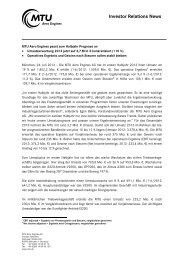
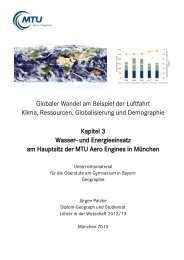
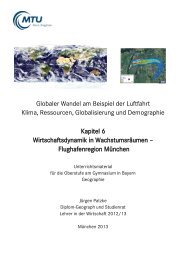
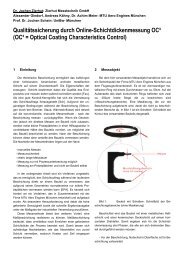
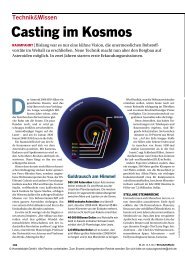

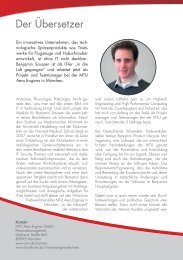
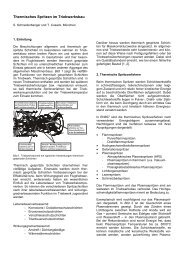
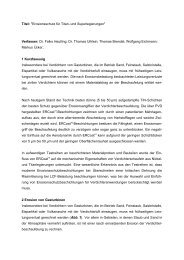


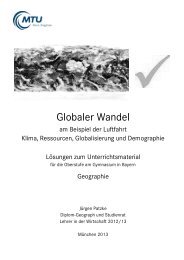
![Download PDF [5,37 MB] - MTU Aero Engines](https://img.yumpu.com/21945461/1/190x125/download-pdf-537-mb-mtu-aero-engines.jpg?quality=85)